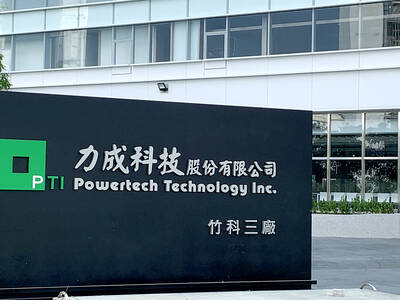US chipmaker Intel Corp is expected to regain its position as the world’s largest semiconductor supplier by sales this year, two years after losing the crown to Samsung Electronics Co, IC Insights said yesterday.
Intel is forecast to post sales of US$69.83 billion, little changed from last year, but more than enough to surpass Samsung, which is expected to see sales plunge 29 percent to US$55.61 billion due to slumping memorychip prices, IC Insights said.
The global memorychip market is forecast to nosedive 34 percent this year from a year ago, the US researcher said.
Taiwan Semiconductor Manufacturing Co (TSMC, 台積電), the world’s largest foundry company, would improve its ranking by one notch to No. 3, on sales of US$34.5 billion, up 1 percent from last year, IC Insights projected.
SK Hynix Inc, the world’s No. 2 memorychip maker last year, would drop to fourth this year, as its sales are expected to plummet 38 percent to US$22.29 billion, down from US$36.77 billion last year, while Micron Technology Co’s sales are forecast to fall 35 percent to US$19.96 billion, ranking fifth, the researcher’s tallies showed.
Taiwanese chip designer Media-Tek Inc (聯發科) is to take the 15th spot this year, down one place from last year, as it is to see sales grow just 1 percent to US$7.95 billion from last year’s US$7.89 billion, IC Insights said.
TSMC is the only pure foundry on the top 15 list.
If the firm is excluded from the ranking, China’s Hisilicon Technologies Co (海思半導體) would move into 15th, on sales of US$7.5 billion, up 24 percent from last year, IC Insights said.
Hisilicon is the chip designing arm of Huawei Technologies Co (華為).
Overall, the world’s top 15 semiconductor companies are to see combined sales fall 15 percent to US$314.89 billion this year from US$369.35 billion last year, IC Insights forecast.
The contraction would be deeper than the global semiconductor industry’s forecast annual decline of 13 percent, the researcher said.

Taiwan Semiconductor Manufacturing Co (TSMC, 台積電) has secured three construction permits for its plan to build a state-of-the-art A14 wafer fab in Taichung, and is likely to start construction soon, the Central Taiwan Science Park Bureau said yesterday. Speaking with CNA, Wang Chun-chieh (王俊傑), deputy director general of the science park bureau, said the world’s largest contract chipmaker has received three construction permits — one to build a fab to roll out sophisticated chips, another to build a central utility plant to provide water and electricity for the facility and the other to build three office buildings. With the three permits, TSMC

The DBS Foundation yesterday announced the launch of two flagship programs, “Silver Motion” and “Happier Caregiver, Healthier Seniors,” in partnership with CCILU Ltd, Hondao Senior Citizens’ Welfare Foundation and the Garden of Hope Foundation to help Taiwan face the challenges of a rapidly aging population. The foundation said it would invest S$4.91 million (US$3.8 million) over three years to foster inclusion and resilience in an aging society. “Aging may bring challenges, but it also brings opportunities. With many Asian markets rapidly becoming super-aged, the DBS Foundation is working with a regional ecosystem of like-minded partners across the private, public and people sectors

BREAKTHROUGH TECH: Powertech expects its fan-out PLP system to become mainstream, saying it can offer three-times greater production throughput Chip packaging service provider Powertech Technology Inc (力成科技) plans to more than double its capital expenditures next year to more than NT$40 billion (US$1.31 billion) as demand for its new panel-level packaging (PLP) technology, primarily used in chips for artificial intelligence (AI) applications, has greatly exceeded what it can supply. A significant portion of the budget, about US$1 billion, would be earmarked for fan-out PLP technology, Powertech told investors yesterday. Its heavy investment in fan-out PLP technology over the past 10 years is expected to bear fruit in 2027 after the technology enters volume production, it said, adding that the tech would

RUN IT BACK: A succesful first project working with hyperscalers to design chips encouraged MediaTek to start a second project, aiming to hit stride in 2028 MediaTek Inc (聯發科), the world’s biggest smartphone chip supplier, yesterday said it is engaging a second hyperscaler to help design artificial intelligence (AI) accelerators used in data centers following a similar project expected to generate revenue streams soon. The first AI accelerator project is to bring in US$1 billion revenue next year and several billion US dollars more in 2027, MediaTek chief executive officer Rick Tsai (蔡力行) told a virtual investor conference yesterday. The second AI accelerator project is expected to contribute to revenue beginning in 2028, Tsai said. MediaTek yesterday raised its revenue forecast for the global AI accelerator used